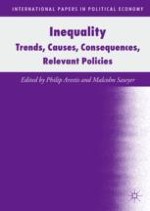2018 | OriginalPaper | Chapter
Rich Become Richer and Poor Become Poorer: A Wealth Inequality Approach from Great Britain
Authors : Dimitra Kavarnou, Nikodem Szumilo
Published in: Inequality
Publisher: Springer International Publishing
Activate our intelligent search to find suitable subject content or patents.
Select sections of text to find matching patents with Artificial Intelligence. powered by
Select sections of text to find additional relevant content using AI-assisted search. powered by
